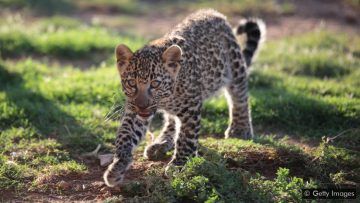Heather Richardson in BBC:
 A grimace revealing powerful yellow incisors clearly indicated we were too close. As our game drive vehicle gently reversed, the female leopard, Thandi, relaxed and settled back in the thicket with her seven-month-old cub, panting as she digested her latest kill. An impala carcass hung limply in the branches nearby. Leopards are famously elusive – but here in the private Sabi Sands Game Reserve, on the edge of Kruger National Park in South Africa, these cats are so habituated to human presence, they’re commonly seen strolling nonchalantly past vehicles of tourists, unconcerned by the frantic clicking of cameras. Though their presence in the Sabi Sands might suggest otherwise, South Africa’s leopard population faces an uncertain future. In a country where reserves and national parks are surrounded by farms, roads and developments, leopards have been forced into ever smaller areas. In some populations, as one recent paper shows, this has led to inbreeding – something that can have long-lasting, catastrophic effects, impacting the cats’ resistance to illnesses and climate events like droughts, and even resulting in local extinction.
A grimace revealing powerful yellow incisors clearly indicated we were too close. As our game drive vehicle gently reversed, the female leopard, Thandi, relaxed and settled back in the thicket with her seven-month-old cub, panting as she digested her latest kill. An impala carcass hung limply in the branches nearby. Leopards are famously elusive – but here in the private Sabi Sands Game Reserve, on the edge of Kruger National Park in South Africa, these cats are so habituated to human presence, they’re commonly seen strolling nonchalantly past vehicles of tourists, unconcerned by the frantic clicking of cameras. Though their presence in the Sabi Sands might suggest otherwise, South Africa’s leopard population faces an uncertain future. In a country where reserves and national parks are surrounded by farms, roads and developments, leopards have been forced into ever smaller areas. In some populations, as one recent paper shows, this has led to inbreeding – something that can have long-lasting, catastrophic effects, impacting the cats’ resistance to illnesses and climate events like droughts, and even resulting in local extinction.
“You’re looking at anything between 70 to 100 years to recover any kind of diversity,” says the paper’s lead author, Vincent Naude, a PhD candidate at the University of Cape Town. In the face of global development, how can conservationists protect species like leopards that require room to roam, but are increasingly meeting barriers, from busy roads to conflicts with farmers?
More here.
